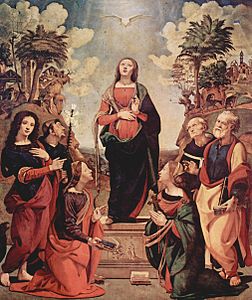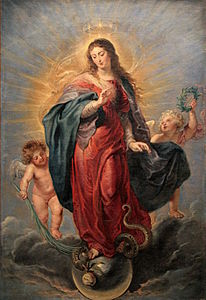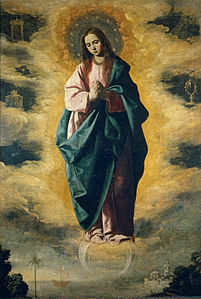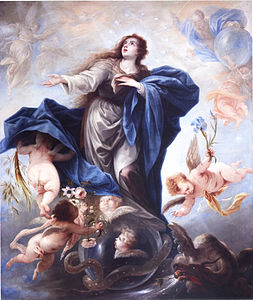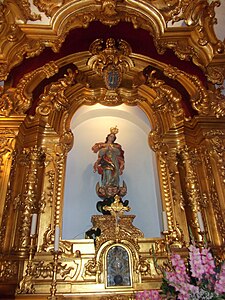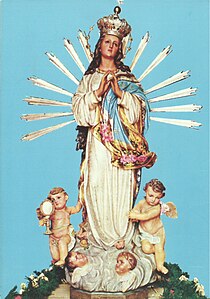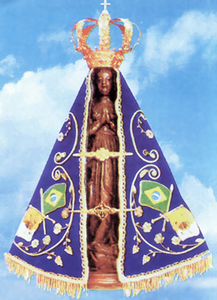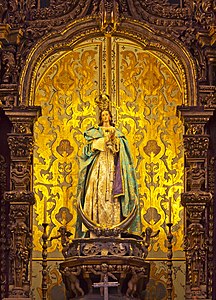Immaculate Conception
Immaculate Conception of Mary | |
|---|---|
 | |
| Venerated in | |
| Feast | December 8 (Roman Rite) December 9 (Byzantine Rite) |
| Attributes | crescent moon, halo of twelve stars, blue robe, putti, serpent underfoot, Assumption into heaven |
| Patronage | |
The Immaculate Conception is the conception of the Blessed Virgin Mary free from original sin by virtue of the merits of her son Jesus Christ. The Catholic Church teaches that God acted upon Mary in the first moment of her conception keeping her "immaculate".[1]
The Immaculate Conception is commonly confused with the Virgin Birth of Jesus. Jesus' birth is covered by the Doctrine of Incarnation, while the Immaculate Conception deals with the conception of Mary, not that of her son.
Although the belief that Mary was sinless, or conceived without original sin, has been widely held since Late Antiquity, the doctrine was not dogmatically defined until 1854, by Pope Pius IX in his papal bull Ineffabilis Deus.[2] The Catholic Church celebrates the Feast of the Immaculate Conception on December 8; in many Catholic countries, it is a holy day of obligation or patronal feast, and in some a national public holiday.[3]
Definition
The defined dogma of the Immaculate Conception states that
- "the most Blessed Virgin Mary, in the first instance of her conception, by a singular grace and privilege granted by Almighty God, in view of the merits of Jesus Christ, the Saviour of the human race, was preserved free from all stain of original sin" (ab omni originalis culpae labe praeservatam immunem).[4]
The definition concerns original sin only, and it makes no declaration about the Church's belief that the Blessed Virgin was sinless in the sense of freedom from actual or personal sin.[5] The doctrine teaches that from her conception Mary, being always free from original sin, received the sanctifying grace that would normally come with baptism after birth.
Possibility of personal sin
The Encyclical Mystici Corporis from Pope Pius XII (1943) in addition holds that Mary was also sinless personally, "free from all sin, original or personal".[6] In this, Pius XII repeats a position already expressed by the Council of Trent, which decreed "If anyone shall say that a man once justified can sin no more, nor lose grace, and that therefore he who falls and sins was never truly justified; or, on the contrary, that throughout his whole life he can avoid all sins even venial sins, except by a special privilege of God, as the Church holds in regard to the Blessed Virgin: let him be anathema."[7]
| Part of a series of articles on |
| Mother of Jesus |
| Chronology |
|---|
|
|
| Marian perspectives |
|
|
| Catholic Mariology |
|
|
| Marian dogmas |
|
|
| Mary in culture |
Mary's pre-redemption
When defining the dogma in Ineffabilis Deus, Pope Pius IX explicitly affirmed that Mary was redeemed in a manner more sublime. He stated that Mary, rather than being cleansed after sin, was completely prevented from contracting Original Sin in view of the foreseen merits of Jesus Christ, the Savior of the human race. In Luke 1:47, Mary proclaims: "My spirit has rejoiced in God my Saviour." This is referred to as Mary's pre-redemption by Christ. Since the Second Council of Orange against semi-pelagianism, the Catholic Church has taught that even had man never sinned in the Garden of Eden and was sinless, he would still require God's grace to remain sinless.[8][9]
Misconceptions
The doctrine of the immaculate conception (Mary being conceived free from original sin) is not to be confused with the virginal conception of her son Jesus. Catholics believe that Mary was conceived of both parents[10] traditionally known by the names of Saint Joachim and Saint Anne. In 1677, the Holy See condemned the error of Imperiali who taught that St. Anne in the conception and birth of Mary remained virgin which had been a belief surfacing occasionally since the 4th century.[11] The Church celebrates the Feast of the Immaculate Conception (when Mary was conceived free from original sin) on 8 December, exactly nine months before celebrating the Nativity of Mary. The feast of the Annunciation (which commemorates the virginal conception and the Incarnation of Jesus) is celebrated on 25 March, nine months before Christmas Day.[12][13]
History
A feast of the Conception of the Most Holy and All Pure Mother of God was celebrated in Syria on 8 December perhaps as early as the 5th century. The title of achrantos (spotless, immaculate, all-pure) refers to the holiness of Mary, not specifically to the holiness of her conception.[14]
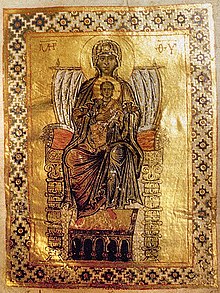
Mary's complete sinlessness and concomitant exemption from any taint from the first moment of her existence was a doctrine familiar to Greek theologians of Byzantium. Beginning with St. Gregory Nazianzen, his explanation of the "purification" of Jesus and Mary at the circumcision (Luke 2:22) prompted him to consider the primary meaning of "purification" in Christology (and by extension in Mariology) to refer to a perfectly sinless nature that manifested itself in glory in a moment of grace (e.g., Jesus at his Baptism). St. Gregory Nazianzen designated Mary as "prokathartheisa (prepurified)." Gregory likely attempted to solve the riddle of the Purification of Jesus and Mary in the Temple through considering the human natures of Jesus and Mary as equally holy and therefore both purified in this manner of grace and glory.[16] Gregory's doctrines surrounding Mary's purification were likely related to the burgeoning commemoration of the Mother of God in and around Constantinople very close to the date of Christmas.[17] Nazianzen's title of Mary at the Annunciation as "prepurified" was subsequently adopted by all theologians interested in his Mariology to justify the Byzantine equivalent of the Immaculate Conception. This is especially apparent in the Fathers St. Sophronios of Jerusalem and St. John Damascene, who will be treated below in this article at the section on Church Fathers. About the time of Damascene, the public celebration of the "Conception of St. Ann [i.e., of the Theotokos in her womb]" was becoming popular. After this period, the "purification" of the perfect natures of Jesus and Mary would not only mean moments of grace and glory at the Incarnation and Baptism and other public Byzantine liturgical feasts, but purification was eventually associated with the feast of Mary's very conception (along with her Presentation in the Temple as a toddler) by Orthodox authors of the 2nd millennium (e.g., St. Nicholas Cabasilas[18] and Joseph Bryennius).[19]
Church Fathers
It is admitted that the doctrine as defined by Pius IX was not explicitly mooted before the 12th century. It is also agreed that "no direct or categorical and stringent proof of the dogma can be brought forward from Scripture".[20] But it is claimed that the doctrine is implicitly contained in the teaching of the Fathers. Their expressions on the subject of the sinlessness of Mary are, it is pointed out, so ample and so absolute that they must be taken to include original sin as well as actual. Thus in the first five centuries such epithets as "in every respect holy", "in all things unstained", "super-innocent", and "singularly holy" are applied to her; she is compared to Eve before the fall, as ancestress of a redeemed people; she is "the earth before it was accursed". The well-known words of St. Augustine (d. 430) may be cited: "As regards the mother of God," he says, "I will not allow any question whatever of sin." It is true that he is here speaking directly of actual or personal sin. But his argument is that all men are sinners; that they are so through original depravity; that this original depravity may be overcome by the grace of God, and he adds that he does not know but that Mary may have had sufficient grace to overcome sin "of every sort" (omni ex parte).[5]
Although the doctrine of Mary's Immaculate Conception appears only later among Latin (and particularly Frankish) theologians,[21] it became ever more manifest among Byzantine theologians reliant on Gregory Nazianzen's Mariology in the Medieval or Byzantine East. Although hymnographers and scholars, like the Emperor Justinian I, were accustomed to call Mary "prepurified" in their poetic and credal statements, the first point of departure for more fully commenting on Nazianzen's meaning occurs in Sophronius of Jerusalem.[22] In other places Sophronius explains that the Theotokos was already immaculate, when she was "purified" at the Annunciation and goes so far as to note that John the Baptist is literally "holier than all 'Men' born of woman" since Mary's surpassing holiness signifies that she was holier than even John after his sanctification in utero.[23] Sophronius' teaching is augmented and incorporated by St. John Damascene (d. 749/750). John, besides many passages wherein he extolls the Theotokos for her purification at the Annunciation, grants her the unique honor of "purifying the waters of baptism by touching them." This honor was most famously and firstly attributed to Christ, especially in the legacy of Nazianzen. As such, Nazianzen's assertion of parallel holiness between the prepurified Mary and purified Jesus of the New Testament is made even more explicit in Damascene in his discourse on Mary's holiness to also imitate Christ's baptism at the Jordan.[24] The Damascene's hymnongraphy and De fide Orthodoxa explicitly use Mary's "pre purification" as a key to understanding her absolute holiness and unsullied human nature. In fact, Damascene (along with Nazianzen) serves as the source for nearly all subsequent promotion of Mary's complete holiness from her Conception by the "all pure seed" of Joachim and the womb "wider than heaven" of St. Ann.[25]
Medieval dispute about the doctrine
| Part of a series on the |
| Mariology of the Catholic Church |
|---|
 |
|
|
Bernard of Clairvaux in the 12th century raised the question of the Immaculate Conception. A feast of the Conception of the Blessed Virgin had already begun to be celebrated in some churches of the West. St Bernard blames the canons of the metropolitan church of Lyon for instituting such a festival without the permission of the Holy See. In doing so, he takes occasion to repudiate altogether the view that the conception of Mary was sinless. It is doubtful, however, whether he was using the term "conception" in the same sense in which it is used in the definition of Pope Pius IX. Bernard would seem to have been speaking of conception in the active sense of the mother's cooperation, for in his argument he says: "How can there be absence of sin where there is concupiscence (libido)?" and stronger expressions follow, showing that he is speaking of the mother and not of the child.[5]
Saint Thomas Aquinas refused to concede the Immaculate Conception, on the ground that, unless the Blessed Virgin had at one time or other been one of the sinful, she could not justly be said to have been redeemed by Christ.[26]
Saint Bonaventure (d. 1274), second only to Saint Thomas in his influence on the Christian schools of his age, hesitated to accept it for a similar reason.[5] He believed that Mary was completely free from sin, but that she was not given this grace at the instant of her conception.[27]
The celebrated John Duns Scotus (d. 1308), a Friar Minor like Saint Bonaventure, argued, on the contrary, that from a rational point of view it was certainly as little derogatory to the merits of Christ to assert that Mary was by him preserved from all taint of sin, as to say that she first contracted it and then was delivered.[5] Proposing a solution to the theological problem of reconciling the doctrine with that of universal redemption in Christ, he argued that Mary's immaculate conception did not remove her from redemption by Christ; rather it was the result of a more perfect redemption granted her because of her special role in salvation history.[28]
The arguments of Scotus, combined with a better acquaintance with the language of the early Fathers, gradually prevailed in the schools of the Western Church. In 1387 the university of Paris strongly condemned the opposite view.[5]
Scotus's arguments remained controversial, however, particularly among the Dominicans, who were willing enough to celebrate Mary's sanctificatio (being made free from sin) but, following the Dominican Thomas Aquinas' arguments, continued to insist that her sanctification could not have occurred until after her conception.[20]
Popular opinion remained firmly behind the celebration of Mary's conception. In 1439, the Council of Basel, which is not reckoned an ecumenical council, stated that belief in the immaculate conception of Mary is in accord with the Catholic faith.[29] By the end of the 15th century the belief was widely professed and taught in many theological faculties, but such was the influence of the Dominicans, and the weight of the arguments of Thomas Aquinas (who had been canonised in 1323 and declared "Doctor Angelicus" of the Church in 1567) that the Council of Trent (1545–63)—which might have been expected to affirm the doctrine—instead declined to take a position.[20][30]
The papal bull defining the dogma, Ineffabilis Deus (1854), mentioned in particular the patrististic interpretation of Genesis 3:15 as referring to a woman, Mary, who would be eternally at enmity with the evil serpent and completely triumphing over him. It said the Fathers saw foreshadowings of Mary's "wondrous abundance of divine gifts and original innocence" "in that ark of Noah, which was built by divine command and escaped entirely safe and sound from the common shipwreck of the whole world; in the ladder which Jacob saw reaching from the earth to heaven, by whose rungs the angels of God ascended and descended, and on whose top the Lord himself leaned;[31] in that bush which Moses saw in the holy place burning on all sides, which was not consumed or injured in any way but grew green and blossomed beautifully;[32] in that impregnable tower before the enemy, from which hung a thousand bucklers and all the armor of the strong;[33] in that garden enclosed on all sides, which cannot be violated or corrupted by any deceitful plots;[34] in that resplendent city of God, which has its foundations on the holy mountains;[35] in that most august temple of God, which, radiant with divine splendours, is full of the glory of God;[36] and in very many other biblical types of this kind."
The bull recounts that the Fathers interpreted the angel's address to Mary, "highly favoured one" or "full of grace",[37] as indicating that "she was never subject to the curse and was, together with her Son, the only partaker of perpetual benediction"; they "frequently compare her to Eve while yet a virgin, while yet innocence, while yet incorrupt, while not yet deceived by the deadly snares of the most treacherous serpent".
Definition of the dogma
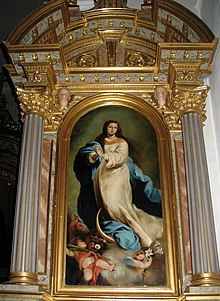
The theological underpinnings of Immaculate Conception had been the subject of debate during the Middle Ages with opposition provided by figures such as Saint Thomas Aquinas, a Dominican. However, supportive arguments by Franciscans William of Ware and Duns Scotus, and general belief among Catholics made the doctrine more acceptable, so that the Council of Basel supported it in the 15th century, but the Council of Trent sidestepped the question. Pope Sixtus IV, a Franciscan, had tried to pacify the situation by forbidding either side from criticizing each other, and placed the feast of the Immaculate Conception on the Roman Calendar in 1477, but Pope Pius V, a Dominican, changed it to the feast of the Conception of Mary. Clement XI made the feast universal in 1708, but still did not call it the feast of the Immaculate Conception.[38] Popular and theological support for the concept continued to grow and by the 18th century it was widely depicted in art.[39][40][41][42]
During the reign of Pope Gregory XVI the bishops in various countries began to press for a definition as dogma of the teaching of Mary's immaculate conception.[43]
In 1839 Mariano Spada (1796 - 1872), professor of theology at the Roman College of Saint Thomas, published Esame Critico sulla dottrina dell’ Angelico Dottore S. Tommaso di Aquino circa il Peccato originale, relativamente alla Beatissima Vergine Maria [A critical examination of the doctrine of St. Thomas Aquinas, the Angelic Doctor, regarding original sin with respect to the Most Blessed Virgin Mary],[44] in which Aquinas is interpreted not as treating the question of the Immaculate Conception later formulated in the papal bull Ineffabilis Deus but rather the sanctification of the fetus within Mary's womb. Spada furnished an interpretation whereby Pius IX was relieved of the problem of seeming to foster a doctrine not in agreement with the Aquinas' teaching.[45] Pope Pius IX would later appoint Spada Master of the Sacred Palace in 1867.
Pius IX, at the beginning of his pontificate, and again after 1851, appointed commissions to investigate the whole subject, and he was advised that the doctrine was one which could be defined and that the time for a definition was opportune.
It was not until 1854 that Pope Pius IX, with the support of the overwhelming majority of Roman Catholic bishops, whom he had consulted between 1851–1853, promulgated the papal bull Ineffabilis Deus (Latin for "Ineffable God"), which defined ex cathedra the dogma of the Immaculate Conception:[46]
We declare, pronounce and define that the doctrine which holds that the Blessed Virgin Mary, at the first instant of her conception, by a singular privilege and grace of the Omnipotent God, in virtue of the merits of Jesus Christ, the Saviour of mankind, was preserved immaculate from all stain of original sin, has been revealed by God, and therefore should firmly and constantly be believed by all the faithful.
— Pope Pius IX, Ineffabilis Deus, December 8, 1854[47]
The dogma was defined in accordance with the conditions of papal infallibility, which would be defined in 1870 by the First Vatican Council.
The papal definition of the dogma declares with absolute certainty and authority that Mary possessed sanctifying grace from the first instant of her existence and was free from the lack of grace caused by the original sin at the beginning of human history. Mary's salvation was won by her son Jesus Christ through his passion, death, and resurrection and was not due to her own merits.[30][48]
Claim of origin in Islamic doctrine

George Sale in 1734 proposed that the doctrine of immaculate conception of Mary may be alluded to in the text of the Qur'an. Thus, commenting in 1734 on the passage "I have called her Mary; and I commend her to thy protection, and also her issue, against Satan driven away with stones",[citation needed] Sale stated: "It is not improbable that the pretended immaculate conception of the virgin Mary is intimated in this passage. For according to a tradition of Mohammed, every person that comes into the world, is touched at his birth by the devil, and therefore cries out, Mary and her son only excepted; between whom, and the evil spirit God placed a veil, so that his touch did not reach them. And for this reason they say, neither of them were guilty of any sin, like the rest of the children of Adam."[49] Edward Gibbon in volume 5 of his Decline and Fall of the Roman Empire, published in 1788, wrote: "The Latin Church has not disdained to borrow from the Koran the immaculate conception of his virgin mother." That he was speaking of her immaculate conception by her mother, not of her own virginal conception of Jesus, is shown by his footnote: "In the xiith century the immaculate conception was condemned by St. Bernard as a presumptuous novelty."[50] In the aftermath of the definition of the dogma in 1854, this charge was repeated in an article published in 1865: "Strange as it may appear, that the doctrine which the church of Rome has promulgated, with so much pomp and ceremony, 'for the destruction of all heresies, and the confirmation of the faith of her adherents', should have its origin in the Mohametan Bible; yet the testimony of such authorities as Gibbon, and Sale, and Forster, and Gagnier, and Maracci, leave no doubt as to the marvellous fact."[51]
Without making Islamic belief the origin of the doctrine defined in 1854, a similarity between the two has been noted also by Roman Catholic writers such as Thomas Patrick Hughes,[52] William Bernard Ullathorne,[53] Giancarlo Finazzo.[54]
The English Commentary of the Holy Quran [year needed] argues that this interpretation is misleading, as Islam does not embrace the concept of original sin to begin with, so that Mary could not have been exempt from it.[55][56]
Moreover, Hannah's prayer in the Quran for her child to remain protected from Satan (Shayṭān) was said after it had already been born, not before and expresses a natural concern any righteous parent would have.
A hadith nevertheless states that the only children born without the "touch of Satan" were Mary and Jesus-[57] The specific mention of Mary and Jesus in this hadith has been argued[by whom?][year needed] as taken to "represent a class of people", in keeping with the Arabic language and the Quranic verse [O Satan,] surely thou shalt have no power over My servants, except such of the erring ones as choose to follow thee (15:42).[55]
Later developments
For the Roman Catholic Church the dogma of the Immaculate Conception gained additional significance from the reputed apparitions of Our Lady of Lourdes in 1858. At Lourdes a 14-year-old girl, Bernadette Soubirous, claimed that a beautiful woman appeared to her and said, "I am the Immaculate Conception". Many believe the woman to have been the Blessed Virgin Mary and pray to her as such.[58]
Pope Pius IX defined the dogma of the Immaculate Conception "not so much because of proofs in Scripture or ancient tradition, but due to a profound sensus fidelium and the Magisterium".[59]
Speaking of the witness of the Church Fathers in claiming for Mary titles such as "Free from all contagion of sin", Pope Pius XII wrote:
If the popular praises of the Blessed Virgin Mary be given the careful consideration they deserve, who will dare to doubt that she, who was purer than the angels and at all times pure, was at any moment, even for the briefest instant, not free from every stain of sin?[60]
The Roman Catholic tradition has a well-established philosophy for the study of the Immaculate Conception and the veneration of the Blessed Virgin Mary in the field of Mariology, with Pontifical schools such as the Marianum specifically devoted to this.[61][62]
According to Bernard Ullathorne, a 19th-century English Roman Catholic prelate, "the expressions - The Immaculate Conception - The Immaculate Preservation - The Immunity - and Exception from original sin, are all phrases which bear the same signification, and are used equally to express one and the same mystery."[63]
Patronages
A number of countries are considered to be under the patronage of the Immaculate Conception by pontifical decree.
These include Argentina, Brazil, Korea, Nicaragua, Paraguay, Philippines, Spain (old kingdoms and the present state), the United States and Uruguay.
By royal decree under the House of Braganza, it is the principal Patroness of Portugal.
Feast day
By 750, the feast of her conception (December 8) was widely celebrated in the Byzantine East, under the name of the Conception (active) of Saint Anne. In the West it was known as the feast of the Conception (passive) of Mary, and was associated particularly with the Normans, whether these introduced it directly from the East[64] or took it from English usage.[65] The spread of the feast, by now with the adjective "Immaculate" attached to its title, met opposition on the part of some, on the grounds that sanctification was possible only after conception.[20] Critics included Saints Bernard of Clairvaux, Albertus Magnus and Thomas Aquinas. Other theologians defended the expression "Immaculate Conception", pointing out that sanctification could be conferred at the first moment of conception in view of the foreseen merits of Christ, a view held especially by Franciscans.[66]
William of Ware and Blessed John Duns Scotus pointed out that Mary’s Immaculate Conception enhances Jesus’ redemptive work.[67] One of the chief proponents of the doctrine was the Hungarian Franciscan Pelbartus Ladislaus of Temesvár. [68]
On 28 February 1476, Pope Sixtus IV, authorized those dioceses that wished to introduce the feast to do so, and introduced it to his own diocese of Rome in 1477,[65] with a specially composed Mass and Office of the feast.[69] With his bull Cum praeexcelsa of 28 February 1477, in which he referred to the feast as that of the Conception of Mary, without using the word "Immaculate", he granted indulgences to those who would participate in the specially composed Mass or Office on the feast itself or during its octave, and he used the word "immaculate" of Mary, but applied instead the adjective "miraculous" to her conception.[70][71] On 4 September 1483, referring to the feast as that of "the Conception of Immaculate Mary ever Virgin", he condemned both those who called it mortally sinful and heretical to hold that the "glorious and immaculate mother of God was conceived without the stain of original sin" and those who called it mortally sinful and heretical to hold that "the glorious Virgin Mary was conceived with original sin", since, he said, "up to this time there has been no decision made by the Roman Church and the Apostolic See."[70] This decree was reaffirmed by the Council of Trent.[70]
Pope Pius V, while including the feast in the Tridentine Calendar, removed the adjective "Immaculate" and suppressed the existing special Mass for the feast, directing that the Mass for the Nativity of Mary (with the word "Nativity" replaced by "Conception") be used instead.[72][73] Part of that earlier Mass was revived in the Mass that Pope Pius IX ordered to be used on the feast and that is still in use.[74]
On 6 December 1708, Pope Clement XI made the feast of the Conception of Mary, at that time still with the Nativity of Mary formula for the Mass, a Holy Day of Obligation.[20] Until Pope Pius X reduced in 1911 the number of Holy Days of Obligation to 8, there were in the course of the year 36 such days, apart from Sundays.[75] Writers such as Sarah Jane Boss interpret the existence of the feast as a strong indication of the Church's traditional belief in the Immaculate Conception.[76]

Other churches
For differing reasons, belief in Mary's immaculate conception in the Catholic doctrinal form is not part of the official doctrines of the Eastern Orthodox, Oriental Orthodox, Anglican and Protestant churches.
Eastern Orthodox

Contemporary Eastern Orthodox Christians often object to the dogmatic declaration of her immaculate conception as an "over-elaboration" of the faith and because they see it as too closely connected with a particular interpretation of the doctrine of ancestral sin.[77] All the same, the historical and authentic tradition of Mariology in Byzantium took its historical point of departure from Sophronios, Damascene, and their imitators. The most famous Eastern Orthodox theologian to imply Mary's Immaculate Conception was St. Gregory Palamas. Though many passages from his works were long known to extol and attribute to Mary a Christlike holiness in her human nature, traditional objections to Palamas' disposition toward the Immaculate Conception typically rely on a poor understanding of his doctrine of "the purification of Mary" at the Annunciation.[78] Not only did he explicitly cite St. Gregory Nazianzen for his understanding of Jesus' purification at His baptism and Mary's at the Annunciation, but Theophanes of Nicaea, Joseph Bryennius, and Gennadios Scholarios all explicitly placed Mary's Conception as the first moment of her all-immaculate participation in the divine energies to such a degree that she was always completely without spot and graced.[79] In addition to Emperor Manuel II and Gennadius Scholarius, St. Mark of Ephesus also fervently defended Mary's title as "prepurified" against the Dominican, Manuel Calecas, who was perhaps promoting thomistic Mariology that denied Mary's all-holiness from the first moment of her existence.[80]
Oriental Orthodox
In the tradition of Ethiopian Orthodoxy, the Kebra Nagast says:
He cleansed EVE'S body and sanctified it and made for it a dwelling in her for ADAM'S salvation. She [i.e., MARY] was born without blemish, for He made her pure, without pollution, and she redeemed his debt without carnal union and embrace ... Through the transgression of EVE we died and were buried, and by the purity of MARY we receive honour, and are exalted to the heights.
— Kebra Nagast (emphasis added)[81]
Old Catholic
While Old Catholics do not reject the Immaculate Conception of Mary, and some of their parishes venerate Mary as immaculately conceived and celebrate the feast of her Immaculate Conception, they do not accept its definition as a dogma, since they reject papal infallibility and with it the Pope's authority to define dogma.[82]
Protestantism
Martin Luther, who initiated the Protestant Reformation, said: "Mother Mary, like us, was born in sin of sinful parents, but the Holy Spirit covered her, sanctified and purified her so that this child was born of flesh and blood, but not with sinful flesh and blood. The Holy Spirit permitted the Virgin Mary to remain a true, natural human being of flesh and blood, just as we. However, he warded off sin from her flesh and blood so that she became the mother of a pure child, not poisoned by sin as we are. For in that moment when she conceived, she was a holy mother filled with the Holy Spirit and her fruit is a holy pure fruit, at once God and truly man, in one person."[83] Some Lutherans, such as the members of the Anglo-Lutheran Catholic Church, support the doctrine.
Most Protestants reject the doctrine because they do not consider the development of dogmatic theology to be authoritative apart from biblical exegesis, and because the doctrine of the Immaculate Conception is not taught in the Bible.[84] The formal pronouncement of Mary's Immaculate Conception by the Catholic Church in 1854 further alienated some Protestant churches largely due to its implication that not all have sinned.[85]
Anglicanism
Belief in Mary's immaculate conception is not a doctrine within Anglicanism, although it is shared by many Anglo-Catholics.[86] In the Church of England's Common Worship prayer book, 8 December is designated a Lesser Festival of the Conception of the Blessed Virgin Mary (without the adjective "immaculate").[87]
The report "Mary: Faith and Hope in Christ", by the Anglican-Roman Catholic International Commission, concluded that the teaching about Mary in the two definitions of the Assumption and the Immaculate Conception can be said to be consonant with the teaching of the Scriptures and the ancient common traditions.[88] But the report expressed concerns that the Roman Catholic dogmatic definitions of these concepts implies them to be "revealed by God", stating: "The question arises for Anglicans, however, as to whether these doctrines concerning Mary are revealed by God in a way which must be held by believers as a matter of faith."[89]
Other than Anglo-Catholics, most Anglicans reject the doctrine that Mary was sinless and conceived without original sin, often citing that it is not within the Holy Scripture and is against the redemptive role and purpose of Jesus Christ merited for all human beings.
Prayers and hymns
The Roman Missal and the Roman Rite Liturgy of the Hours naturally includes references to Mary's immaculate conception in the feast of the Immaculate Conception. An example is the antiphon that begins: "Tota pulchra es, Maria, et macula originalis non est in te" ("You are all beautiful, Mary, and the original stain [of sin] is not in you." It continues: "Your clothing is white as snow, and your face is like the sun. You are all beautiful, Mary, and the original stain [of sin] is not in you. You are the glory of Jerusalem, you are the joy of Israel, you give honour to our people. You are all beautiful, Mary.")[90] On the basis of the original Gregorian chant music,[91] polyphonic settings have been composed by Anton Bruckner,[92] Pablo Casals, Maurice Duruflé,[93] Grzegorz Gerwazy Gorczycki,[94] no:Ola Gjeilo,[95] José Maurício Nunes Garcia,[96] and Nikolaus Schapfl,[97]
Other prayers honouring Mary's immaculate conception are in use outside the formal liturgy. The Immaculata prayer, composed by Saint Maximillian Kolbe, is a prayer of entrustment to Mary as the Immaculata.[98] A novena of prayers, with a specific prayer for each of the nine days has been composed under the title of the Immaculate Conception Novena.[99]
Ave Maris Stella is the vesper hymn of the feast of the Immaculate Conception.[100] The hymn Immaculate Mary, addressed to Mary as the Immaculately Conceived One, is closely associated with Lourdes.[101]
Artistic representations
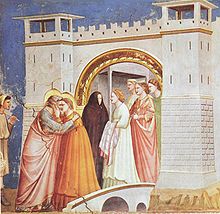

During the Medieval period, the conception of Mary was symbolically depicted in the Meeting at the Golden Gate and was an early scene in the many cycles of the Life of the Virgin, as a counterpart of the Annunciation showing the conception of Jesus. To some medieval viewers, the kiss was a literal representation of the moment of Mary's conception, while for others it was a symbolic representation. The 14th and 15th centuries were the highpoint of these depictions. Gradually more allegorical depictions of the Immaculate Conception, featuring an adult Mary, replaced this scene in representing the doctrine.[102]
The 1476 extension of the feast of the Immaculate Conception to the entire Latin Church reduced the likelihood of controversy for the artist or patron in depicting an image, so that emblems depicting The Immaculate Conception began to appear.[103]
Many artists in the 15th century faced the problem of how to depict an abstract idea such as the Immaculate Conception, and the problem was not fully solved for 150 years. The Italian Renaissance artist Piero di Cosimo was among those artists who tried new solutions, but none of these became generally adopted so that the subject matter would be immediately recognisable to the faithful.
The definitive iconography for the Immaculate Conception, drawing on the emblem tradition, seems to have been finally established by the master and then father-in-law of Diego Velázquez, the painter and theorist Francisco Pacheco. Pacheco's iconography influenced other Spanish artists or artists active in Spain such as El Greco, Bartolomé Murillo, Diego Velázquez, and Francisco Zurbarán, who each produced a number of artistic masterpieces based on the use of these same symbols.[104][105]
The popularity of this particular representation of The Immaculate Conception spread across the rest of Europe, and has since remained the best known artistic depiction of the concept: in a heavenly realm, moments after her creation, the spirit of Mary (in the form of a young woman) looks up in awe at (or bows her head to) God. The moon is under her feet and a halo of twelve stars surround her head, possibly a reference to "a woman clothed with the sun" from Revelation 12:1–2. Additional imagery may include clouds, a golden light, and putti. In some paintings the putti are holding lilies and roses, flowers often associated with Mary.[106]
-
di Cosimo, Immaculate Conception, 1505
-
Rubens, Immaculate Conception, 1628–1629
-
Zurbarán, Immaculate Conception, 1630
-
Murillo, Immaculate Conception, 1650
-
Murillo, Immaculate Conception, 1660
-
Murillo, Immaculate Conception, 1678
-
Carlo Maratta, 1689
-
Juan Antonio Escalante, 17th century
-
Caxias do Sul museum, Brazil
-
Statue, Porto Alegre, Brazil, 19th century
-
Palmi, Immaculate Conception, 1925
-
Nicaragua, Immaculate Conception, 1950
-
Our Lady of Aparecida, Brasilia
See also
- Act for the Immaculate Conception of Mary
- Cathedral of the Immaculate Conception (disambiguation)
- Congregation of the Immaculate Conception
- Feast of the Immaculate Conception
- Immaculate Mary
- Immaculata prayer
- Miraculous medal
- Marian doctrines of the Catholic Church
- Mother of God (Roman Catholic)
- Original sin
- Patronages of the Immaculate Conception
- Perpetual virginity of Mary
- Roman Catholic Marian art
- Virgin birth of Jesus
Bibliography
- "virgin mary - What is the basis for saying that Aquinas accepted the Immaculate Conception? - Christianity Stack Exchange" (answer). Christianity StackExchange. 2018-02-09. Retrieved 2018-02-09.
- Le Franc, Martin. The Conception of Mary -- A Rhyming Translation of Book V of Le Champion des Dames by Martin Le Franc (1410-1461). Ed. and trans. Steven Millen Taylor. Lewiston, NY: The Edwin Mellen Press, 2010.
- Lumbreras, Pedro, O.P. (1923). "Saint Thomas and the immaculate conception" (PDF). Homiletic and Pastoral Review. 24 (3): 253–263.
{{cite journal}}: CS1 maint: multiple names: authors list (link)- Response: Storff, Hugolinus, O.F.M. (1925). The Immaculate Conception: The Teaching of St. Thomas, St. Bonaventure and Bl. J. Duns Scotus on the Immaculate Conception of the Blessed Virgin Mary. San Francisco, Calif.: St. Francis Press. Retrieved 2018-02-10.
{{cite book}}: CS1 maint: multiple names: authors list (link)
- Response: Storff, Hugolinus, O.F.M. (1925). The Immaculate Conception: The Teaching of St. Thomas, St. Bonaventure and Bl. J. Duns Scotus on the Immaculate Conception of the Blessed Virgin Mary. San Francisco, Calif.: St. Francis Press. Retrieved 2018-02-10.
- Prado, Norbert del, O.P. (1919). Divus Thomas et bulla dogmatica "Ineffabilis Deus". Friburgi Helvetiorum: Ex typis Consociationis sancti Pauli.
{{cite book}}: CS1 maint: multiple names: authors list (link)
References
- ^ Denzinger, 1100.
- ^ "Catechism of the Catholic Church - "Conceived by the power of the Holy Spirit and born of the Virgin Mary"". www.vatican.va.
- ^ "Christianity: Immaculate Conception". BBC. Retrieved 25 May 2014.
- ^ Encyclical Ineffabilis Deus of Pope Pius IX, 1854.
- ^ a b c d e f One or more of the preceding sentences incorporates text from a publication now in the public domain: Chisholm, Hugh, ed. (1911). "THE IMMACULATE CONCEPTION". Encyclopædia Britannica (11th ed.). Cambridge University Press.
- ^ Encyclical Mystici Corporis, 110 Archived March 17, 2009, at the Wayback Machine
- ^ "Catechetics Online". Archived from the original on 2011-07-24.
{{cite web}}: Unknown parameter|deadurl=ignored (|url-status=suggested) (help) - ^ Council of Orange II, Canon 19 Archived 2009-01-13 at the Wayback Machine "That no one is saved except by God's mercy. Even if human nature remained in that integrity in which it was formed, it would in no way save itself without the help of its Creator; therefore, since without the grace of God it cannot guard the health which it received, how without the grace of God will it be able to recover what it has lost?"
- ^ Theology for Beginners by Francis Joseph Sheed 1958 ISBN 0-7220-7425-5 pages 134-138
- ^ As the Catholic Encyclopedia (1913) somewhat coyly puts it, "Her body was formed in the womb of the mother, and the father had the usual share in its formation. The question does not concern the immaculateness of the generative activity of her parents", "Immaculate Conception", Catholic Encyclopedia
- ^ "CATHOLIC ENCYCLOPEDIA: St. Anne".
- ^ The Catholicism Answer Book by John Trigilio, Kenneth Brighenti 2007 ISBN 1-4022-0806-5 page 59-62
- ^ What Every Catholic Should Know about Mary by Terrence J. McNally ISBN 1-4415-1051-6 pages 104-108
- ^ "The celebration of the Mother of God as immaculate (achrantos), is a clear and universal recognition of her exceptional and iconic sanctity. Orthodoxy did not follow the path of Roman Catholicism in moving towards a recognition of her Immaculate Conception" ( John Anthony McGuckin, The Orthodox Church: An Introduction to Its History, Doctrine, and Spiritual Culture (Blackwell 2011 ISBN 978-1-4443-3731-0), p. 218.)
- ^ Raymond Burke, 2008, Mariology: A Guide for Priests, Deacons, seminarians, and Consecrated Persons Queenship Publishing ISBN 1-57918-355-7 page 251
- ^ Patrologia Graeca 36: 326B 41-42; idem, 36: 633C 7-8
- ^ Brian Daley, Gregory of Nazianzus (The Early Christian Church Fathers), New York 2006, 115-118.
- ^ Nicolas Cabasilas (†1371?). Homélies sur la Nativité, L’Annonciation et la Dormition de la Sainte Vierge, ed. M. Jugie (Patrologia Orientalis 19), Turnhout 1990, pp. 456-512 (ch. 10, lines 1-8): "If there are some of the holy doctors who say that the Virgin is ‘prepurified (προκεκαθάρθαι)’ by the Spirit, then it is yet necessary to think that ‘purification (κάθαρσιν)’ (i.e. an addition of graces) is intended by these authors, and these [doctors] say that this is the way the angels are ‘purified,’ with respect to whom there is nothing knavish."
- ^ Joseph Bryennius, Ιὠσῆφ Μαναχοῦ τοῦ Βρυεννίου τὰ εὐρεθέντα, vol. 3, ed. E. Bulgaris (Thessaloniki: 1990), 31: "He says: ‘Yet, on one hand, how did another Mother of God not come about?’ But, on the other hand: ‘Had she some sort of virtue/excellence, because of which she was honored above all women?’ First, another woman was not chosen over her, because while God foreknew all women, he sanctified (ἡγίασεν) the future woman from her mother’s womb, purer (καθαρωτέραν) than other women, who were going to come to exist; but he eschewed all unworthy persons with respect to her, as is reasonable. But she procured for herself the excellence superior to all men and [procured for her] to be prepared as a containing receptacle of the divinity, which [same receptacle] was prepurified (τὸ προκαθαρθῆναι) by the Holy Spirit; O what a marvel, indeed!"
- ^ a b c d e Frederick Holweck, "Immaculate Conception" in The Catholic Encyclopedia 1910
- ^ Brian Reynolds, Gateway to Heaven: Marian Doctrine and Devotion Image and Typology in the Patristic and Medieval Periods, vol. 1 (NY: New City Press, 2012), 348-353.
- ^ Sophronios of Jerusalem, In Sanctissimae Deiparae Annuntiationem (Patrologia Graeca 87.3:3248A 24): "Οὐδεὶς κατά σε μεμακάρισται, οὐδεὶς κατά σε καθαγίασται· οὐδεὶς κατά σε μεμεγάλυνται, οὐδεὶς κατά σε προκεκάθαρται· οὐδεὶς κατά σε περιηύγασται, οὐδεὶς κατά σε ἐκπεφώτισται." N.B., oudeis kata se prokekathartai was rendered in Latin as nemo, sicut tu, purificante gratia praeoccupatus est."
- ^ Sophronios of Jerusalem, In Sanctissimae Deiparae Annuntiationem (Patrologia Graeca, 87.3: 3273D 43): "Πνεῦμα ἅγιον ἐπὶ σὲ, τὴν ἀμόλυντον, κάτεισι, καθαρωτέραν σε ποιησόμενον, καὶ καρπογόνον σοι παρεξόμενον δύναμιν."; idem, Encomium in S. Iohannem Baptistam, PG 87:3332C
- ^ "The air, the fiery ether, the sky would have been made holy by the ascent of her spirit, as earth was sanctified by the deposition of her body. Even water had its share in the blessing: for she was washed in pure water, which did not so much cleanse her as it was itself consecrated." See John Damascene, On the Holy and Glorious Dormition and Transformation of Our Lady Mary, Mother of God and Ever-Virgin by Our Holy Father John, Monk of Damascus and Son of Mansour. Homily 2, in On the Dormition of Mary: Early Patristic Homilies, tr. B. Daley (Crestwood, NY :1998), 215.
- ^ Christiaan Kappes, The Immaculate Conception: Why Thomas Aquinas Denied, While John Duns Scotus, Gregory Palamas, and Mark Eugenicus Professed the Absolute Immaculate Existence of Mary (Bedford, MA: Academy of the Immaculate, 2014), 39-61
- ^ "Summa Theologica, Volume 4 (Part III, First Section)".
- ^ "Mary's Immaculate Conception".
- ^ Encyclopedia of theology: a concise Sacramentum mundi by Karl Rahner 2004 ISBN 0-86012-006-6 pages 896-898
- ^ ""collegiate encyclopedia" "immaculate conception" - Google Search".
- ^ a b Jenny Schroedel, The Everything Mary Book (Adams 2006 ISBN 1-59337-713-4) pp. 180-181"
- ^ Genesis 28:12
- ^ Exodus 3:2
- ^ Song 4:4
- ^ Song 4:12
- ^ Psalm 87:1
- ^ Isaiah 6:1–4
- ^ Luke 1:28
- ^ Edward Bouverie Pusey, First letter to the Very Rev. J. H. Newman (J. Parker & Co. 1869), p. 379
- ^ Mary in the Christian tradition by Kathleen Coyle 1996 ISBN 0-85244-380-3 page 38
- ^ Encyclopedia of the Middle Ages, Volume 2 by André Vauchez, Richard Barrie Dobson 2001 ISBN 1-57958-282-6 page 348
- ^ Burke, Raymond L.; et al. (2008). Mariology: A Guide for Priests, Deacons, Seminarians, and Consecrated Persons ISBN 978-1-57918-355-4 pages 642-644
- ^ The Catholic Reformation by Michael A. Mullett 1999 ISBN 0-415-18914-4 page 5
- ^ "These petitions were renewed in these our own times; they were especially brought to the attention of Gregory XVI" (Ineffabilis Deus).
- ^ Pareri dell'episcopato cattolico, di capitoli ... etc., sulla definizione ... - Pius IX (pope.) - Google Boeken. Books.google.com. Retrieved 2013-03-12.
- ^ 3-11-2013; Il mistero di Maria: teologia, storia, devozione by Giuseppe Damigella, p. 175: "Pio IX si senti' sollevato dal peso teologico di dover sostenere una dottrina non fondata nel pensiero di san Tommaso, il cui insegnamento era allora, come oggi, ritenuto "sicuro"." Cf. A. Andaloro, "P. Mariano Spada, o.p. interprete di San Tommaso sull'Immucolata Concezione," Catania, 1958
- ^ The Creeds of Christendom by Philip Schaff 2009 ISBN 1-115-46834-0 page 211
- ^ "Papal Definition of the Immaculate Conception". Ewtn.com. Retrieved 2010-09-13.
- ^ Mark Miravalle, 1993, Introduction to Mary, Queenship Publishing ISBN 978-1-882972-06-7 page 64-70
- ^ George Sale, Koran, commonly called the Alcoran of Mohammed, chapter 3, p. 39
- ^ Edward Gibbon, The History of the Decline and Fall of the Roman Empire, vol. V, chapter 50
- ^ "The Evangelical Repository and United Presbyterian Review". 1865.
- ^ Thomas Patrick Hughes, A Dictionary of Islam. First published London 1885; reprinted by Asian Educational Services 2001. ISBN 8120606728, ISBN 9788120606722. Entry "IMMACULATE CONCEPTION". (Google Books) Quote: "This doctrine was asserted by Muhammad (Mishkāt, book i., ch. iii., pt. 1)."
- ^ William Bernard Ullathorne. The Immaculate Conception of the Mother of God: An Exposition. First published 1855; ISBN 1-110-89977-7. Chapter XIV, "Mahomet and Martin Luther". (Google Books)
- ^ Giancarlo Finazzo. "The Virgin Mary in the Koran". L'Osservatore Romano Weekly Edition in English, 13 April 1978, page 4. Quote: "The dogma of the Immaculate Conception ... is univocally recognized by the Islamic religion."
- ^ a b English 5 Volume Commentary https://www.alislam.org/quran/tafseer/?page=386®ion=E1
- ^ Cleo McNelly Kearns, The Virgin Mary, Monotheism and Sacrifice (Cambridge University Press 2008 ISBN 978-0-52187156-3), p. 254
- ^ Bukhari, Anbiya, 44; Muslim, Fada'il, trad. 146, 147
- ^ "Prayer on the Solemnity of the Immaculate Conception of the Blessed Virgin Mary (December 8, 2002) - John Paul II". www.vatican.va.
- ^ "Agenzia Fides - Congregazione per l'Evangelizzazione dei Popoli". Fides.org. Archived from the original on 2009-06-15. Retrieved 2009-05-05.
{{cite web}}: Unknown parameter|deadurl=ignored (|url-status=suggested) (help) - ^ Pope Pius XII, Encyclical Fulgens corona, 10 Archived 2008-04-29 at the Wayback Machine
- ^ Centers of Marian Study "Archived copy". Archived from the original on December 2, 2007. Retrieved February 28, 2008.
{{cite web}}: Unknown parameter|deadurl=ignored (|url-status=suggested) (help)CS1 maint: archived copy as title (link) - ^ Publisher’s Notice in the Second Italian Edition (1986), reprinted in English Edition, Gabriel Roschini, O.S.M. (1989). The Virgin Mary in the Writings of Maria Valtorta (English Edition). Kolbe's Publication Inc. ISBN 2-920285-08-4
- ^ Ullathorne, William Bernard, The immaculate conception of the Mother of God, an exposition, 1855.
- ^ Francis X. Weiser, The Holyday Book (Harcourt, Brace and Co. 1956)
- ^ a b Michael Kunzler, The Church's Liturgy (Continuum International 2002 ISBN 978-0-8264-1353-6), pp. 434-435
- ^ Matthew Bunson, OSV's Encyclopedia of Catholic History (Our Sunday Visitor 2004 ISBN 978-1-59276-026-8), p. 455
- ^ Foley OFM, Leonard. "Solemnity of the Immaculate Conception", Saint of the Day, (revised by Pat McCloskey OFM), AmericanCatholic.org
- ^ Z. J. Kosztolnyik, Some Hungarian Theologians in the Late Renaissance, Church History. Volume: 57. Issue: 1, 1988. Z. J. Kosztolnyik, Pelbartus of Temesvar: a Francican Preacher and Writer of the Late Middle Ages in Hungary, Vivarium, 5/1967. Kenan B. Osborne, O.F.M., The History of Franciscan Theology, The Franciscan Institute St. Bonaventure, New York, 1994. Franklin H. Littell (ed.), Reformation Studies, John Knox Press, Richmond, Virginia, 1962.
- ^ John D. Bryant, The Immaculate Conception of the Blessed Virgin Mary, Mother of God" (Boston 1855), p. 166
- ^ a b c "Catechetics Online". Archived from the original on 2011-07-24.
{{cite web}}: Unknown parameter|deadurl=ignored (|url-status=suggested) (help) - ^ Pilgrimages Committee. "St. Conleth's Catholic Heritage Association: Immaculate Conception".
- ^ "cavendish".
- ^ Decree of Our Most Holy Father Pope Paul V in Favor of the Immaculate Conception of the Blessed Virgin Mary, Mother of God. Lima, Peru : 1618. World Digital Library.
- ^ "LAND OF MARY IMMACULATE".
- ^ "CATHOLIC ENCYCLOPEDIA: Supremi Disciplinae".
- ^ Mary by Sarah Jane Boss, Neil Warmsley 2004 ISBN 0-8264-5788-6 page 139
- ^ John Meyendorff, The Orthodox Church: Its Past and Its Role in the World Today (St Vladimir's Seminary Press 1996 ISBN 978-0-913836-81-1), p. 181
- ^ See https://www.academia.edu/4375213/The_Immaculate_Conception_Why_Thomas_Aquinas_Denied_While_John_Duns_Scotus_Gregory_Palamas_and_Mark_Eugenicus_Professed_the_Absolute_Immaculate_Existence_of_Mary, pp. 69-81
- ^ Christiaan Kappes, The Immaculate Conception: Why Thomas Aquinas Denied, While John Duns Scotus, Gregory Palamas, and Mark Eugenicus Professed the Absolute Immaculate Existence of Mary (Bedford, MA: Academy of the Immaculate, 2014), 69-92; 157-169
- ^ Mark of Ephesus, On the Distinction between Essence and Energy: First Antirrhetic against Manuel Kalekas. Editio princeps, ed. M. Pilavakis (Unpublished doctoral dissertation), London 1987: "But He did so with her, after he prepurified (προκαθαρθείσῃ) her through a most profuse grace by means of the protecting Holy Spirit and divine power ..."
- ^ "The Kebra Nagast: 96. Concerning the Prophecy about CHRIST".
- ^ "Frequently Asked Questions About The North American Old Roman Catholic Church". North American Old Roman Catholic Church. Retrieved 2016-03-13.
- ^ Brecht, Martin (1985). His Road to Reformation, 1483–1521. Martin Luther. Vol. 1. Translated by James Schaaf. Philadelphia: Fortress Press. p. 291. ISBN 978-0-8006-2813-0.
- ^ The Protestant faith by George Wolfgang Forell 1962 ISBN 0-8006-1095-4 page 23
- ^ Jesus in history, thought, and culture: an encyclopedia, Volume 1 by James Leslie Houlden 2003 ISBN 1-57607-856-6 page
- ^ Our Lady Saint Mary by J.G.H. Barry, 2008, ISBN 0-554-24332-6, pages 25-27
- ^ "Common Worship".
- ^ Ecumenical Affairs - Dialogues - Anglican Roman Catholic Paragraph 78 - Accessed 8 December 2008
- ^ Ecumenical Affairs - Dialogues - Anglican Roman Catholic Paragraph 60 - Accessed 8 December 2008
- ^ The text (in Latin) is given at Tota Pulchra Es - GMEA Honor Chorus.
- ^ Tota pulchra es Maria, Canto gregoriano nella devozione mariana, studio di Giovanni Vianini, Milano. 6 November 2008 – via YouTube.
- ^ Anton Bruckner - Tota pulchra es. 3 October 2008 – via YouTube.
- ^ Maurice Duruflé: Tota pulchra es Maria. 23 May 2010 – via YouTube.
- ^ Tota pulchra es - Grzegorz Gerwazy Gorczycki. 17 June 2011 – via YouTube.
- ^ TOTA PULCHRA ES GREX VOCALIS. 21 May 2009 – via YouTube.
- ^ Tota pulchra es, Maria Canto gregoriano nella devozione mariana. 21 September 2008 – via YouTube.
- ^ Tota Pulchra - Composed by Nikolaus Schapfl (*1963). 4 January 2010 – via YouTube.
- ^ "Prayers of Consecration".
- ^ "Nine Days Of Prayer - Immaculate Conception".
- ^ Sutfin, Edward J., True Christmas Spirit, Grail Publications, St. Meinrad, Indiana, 1955
- ^ "Immaculate Conception Prayers".
- ^ Hall, James, Hall's Dictionary of Subjects and Symbols in Art, 1996 (2nd edn.), John Murray, ISBN 0719541476, p. 171
- ^ "The Immaculate Conception in Images".
- ^ Ésotérisme, gnoses & imaginaire symbolique: mélanges offerts à Antoine Faivre by Richard Caron, Antoine Faivre 2001 ISBN 90-429-0955-2 page 676
- ^ Divine Mirrors: The Virgin Mary in the Visual Arts by Melissa R. Katz and Robert A. Orsi 2001 ISBN 0-19-514557-7 page 98
- ^ Our Lady in Art by Katherine Lee Rawlings Jenner 2009 ISBN 1-103-32689-9 pages 3-9
External links
- The Immaculate Conception in Art (Painting)
- Ineffabilis Deus (Apostolic Constitution of Pope Pius IX defining the dogma of the Immaculate Conception)
- Godzinki: The Little Hours of the Immaculate Conception
- St. Alphonsus Liguori's writing on the Immaculate Conception in his book The Glories of Mary
- Catholic Encyclopedia entry on the Immaculate Conception
- Catholic Encyclopedia entry on Original Sin
- The Immaculate Conception. A study by a Melkite archimandrite
- The Immaculate Conception of the Mother of God based on Juniper Carol's Mariology and William Bernard Ullathornee's book
- "St. Augustine and Original Sin" — a short article on the different understandings of Original Sin in Eastern and Western Christianity, without distinguishing Protestant theology from Roman Catholic. The latter holds that "original sin does not have the character of a personal fault in any of Adam's descendants" (Catechism of the Catholic Church, 405).
- Original Sin According To St. Paul by John S. Romanides

